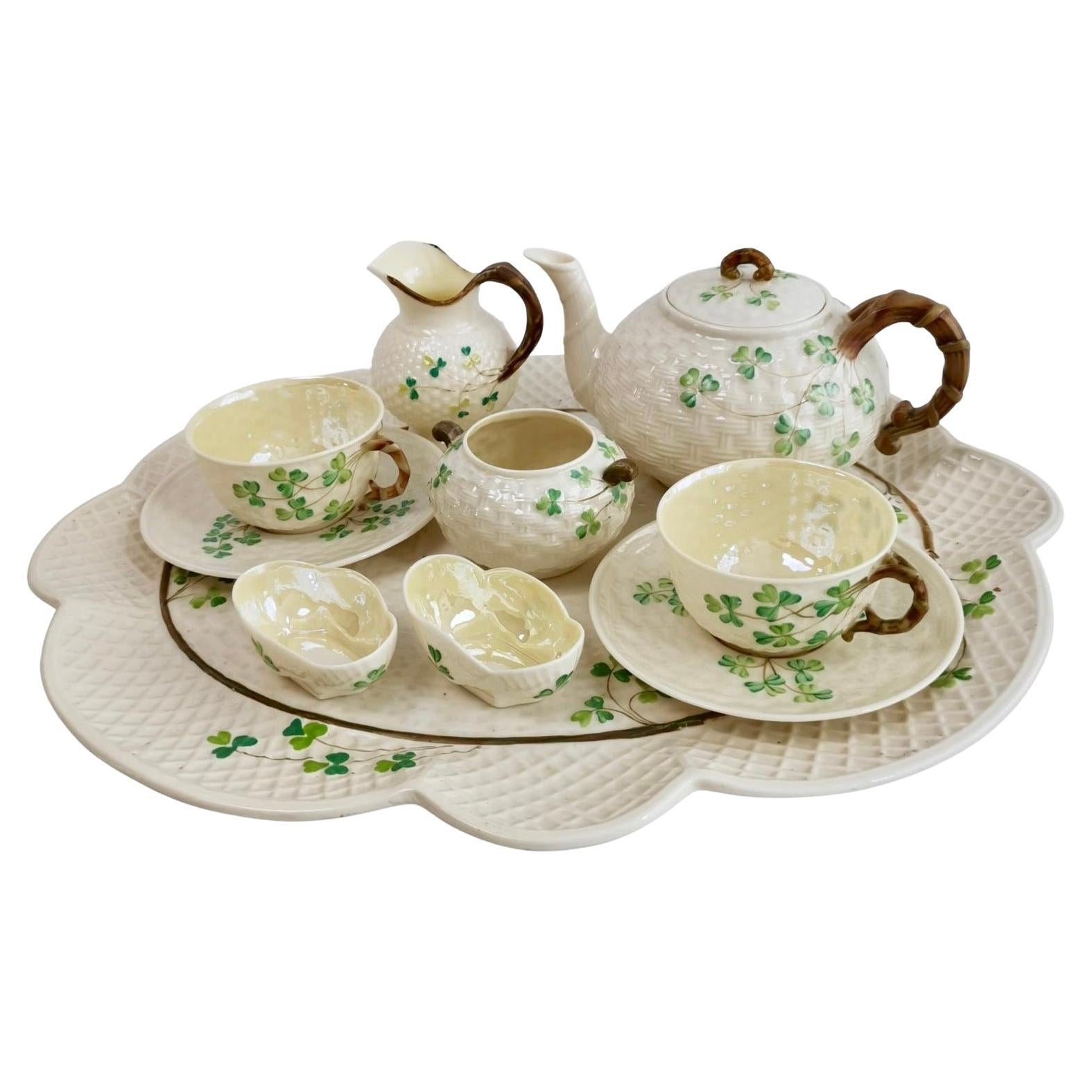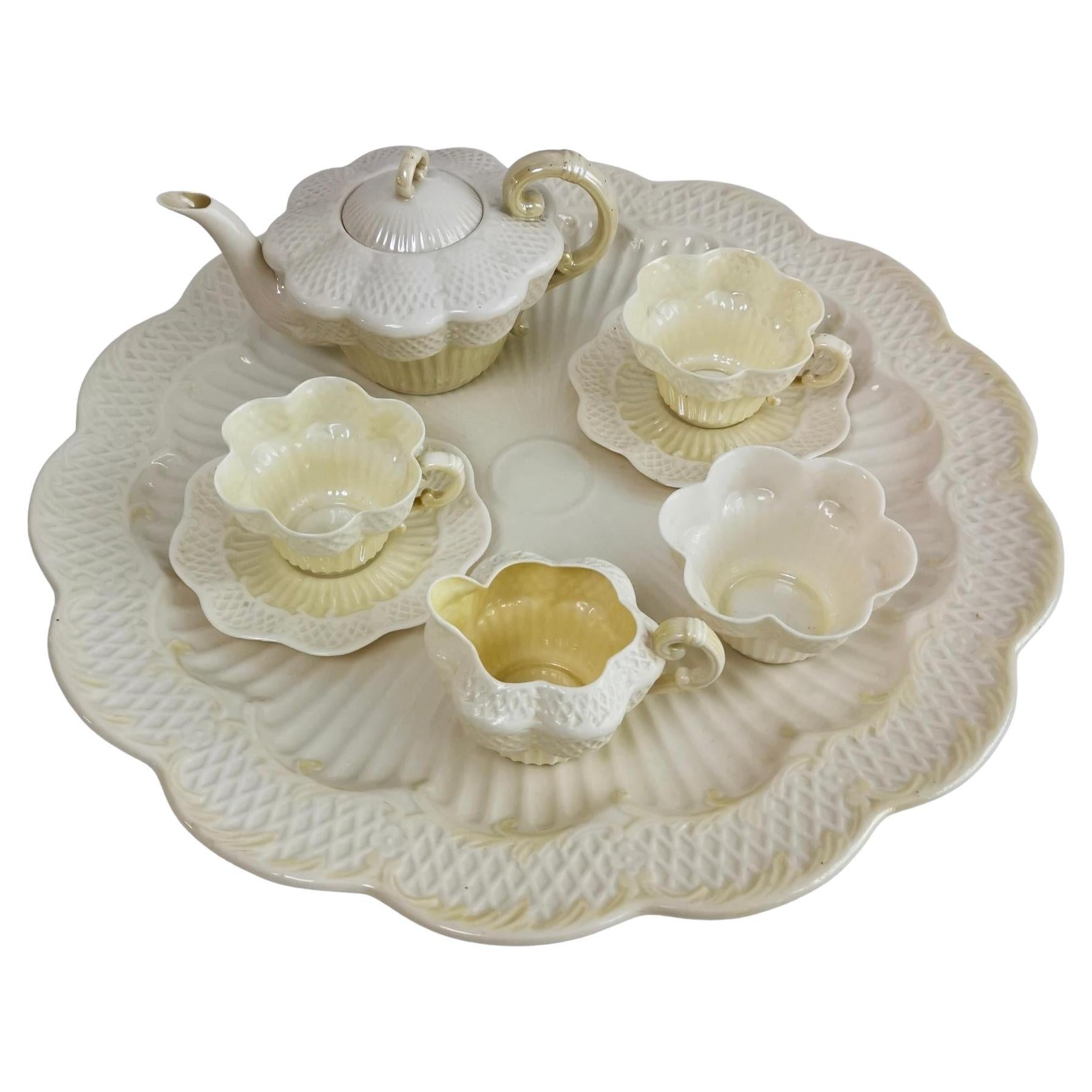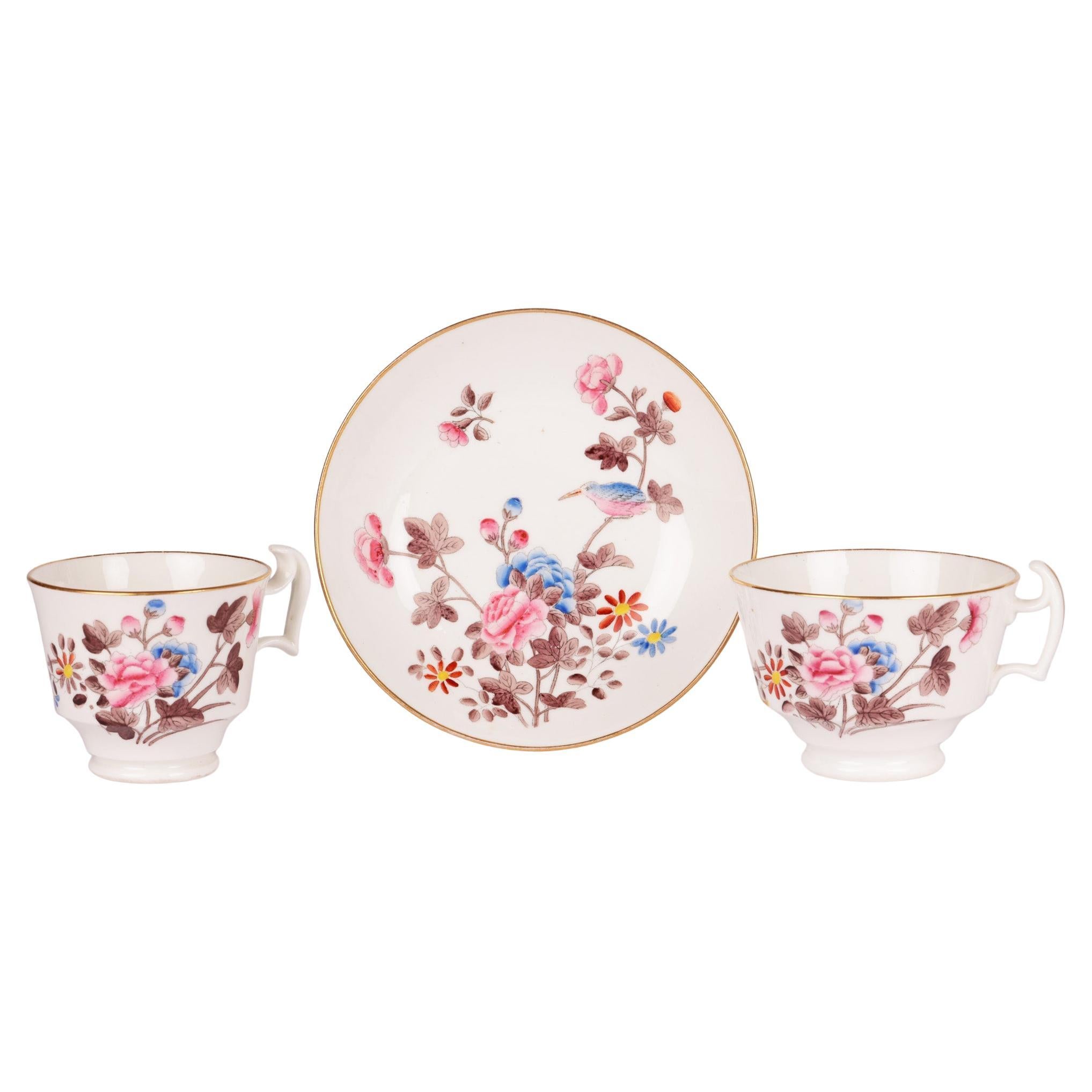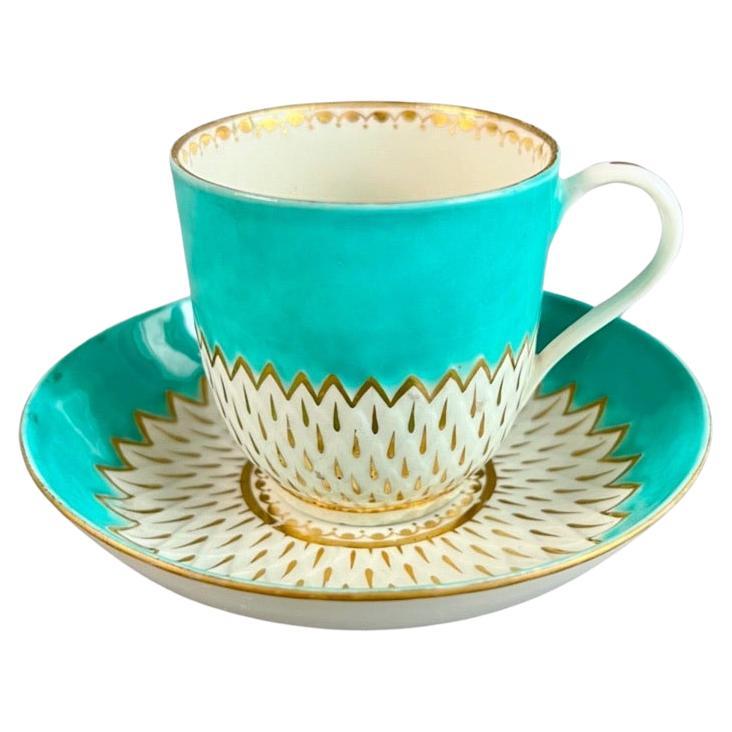Items Similar to Belleek Coffee Cup Trio, Shamrock Pattern, 1891-1926
Want more images or videos?
Request additional images or videos from the seller
1 of 13
Belleek Coffee Cup Trio, Shamrock Pattern, 1891-1926
About the Item
This is a very charming coffee cup trio made by Belleek in the Shamrock design, consisting of a coffee cup, a saucer and a little cake plate. It has the 2nd Black Mark, which was used between 1891 and 1926. Given the quality of the porcelain we think the date of production is probably closer to 1891 than 1926.
If you ever thought Belleek fine china looks, sounds and feels unique, you are right. There is a back story to this extraordinarily fine Irish eggshell porcelain, which has an unusually high amount of "frit" and therefore is thinner and finer than any other china.
Pottery in Belleek (in the now Northern-Irish area of Fermanagh) had started in 1849 with John Caldwell Bloomfield, who was a wealthy land owner. During the Irish famine he realised that unless he would find a way for his tenants to make a profit off the land, they would starve. Agriculture had become impossible due to the agricultural diseases caused by monoculture. This caused millions to starve and more millions to leave. As an amateur mineralogist, John Caldwell Bloomfield realised that his land had exactly the right mineral deposits to be used as clay for porcelain. He involved several investors and scientists and after many years of research, trial, error, the building of a railway line to import coal from England, and building a factory, the Belleek pottery resulted, employing the local people and soon producing the finest china made with clay from the Belleek area.
What had started as a way to fend off famine among the local tenants had became a story of incredible success by the 1880s as Queen Victoria fell in love with the fine white china and the many homely, slightly bizarre but nature-loving designs; this was different from English tradition, yet it was very much to the taste of the British who had developed a real love for home-made fine china since it was introduced in the late 18th Century. Soon the English nobility started to place big orders and the pottery is still flourishing today and selling its wares the world over, while in England most potteries have long disappeared.
The Shamrock series is one of the most classic and popular designs Belleek has made. It could be found in many Irish households and is still made and widely popular today - although these antique items have an unrivalled delicacy that you won't see in contemporary items. Many Belleek designs are inspired by nature rather than by fashion: there are sea shells, froth, kelp, tree roots and bark, corals and woven baskets. The Shamrock series is shaped in the shape of finely woven wicker baskets and has sweet sprigs of shamrock draped across the surface. Each detail is true to the concept; the surface is wonderfully woven, and the teacup handle is made like a twig of wood. The shamrock leaves are finely moulded and painted in two shades of green, wonderfully portraying the uniquely green colour of the Irish landscape.
The set is marked with the 2nd black mark, which was used between 1891 and 1926.
Condition report The set is in perfect antique condition without any damage, repairs, crazing or wear.
Antique porcelain is never perfect. Kilns were fired on coal in the 1800s and early 1900s, and this meant that china from that period can have some firing specks from flying particles. Makers were also known for their experimentation, and sometimes this resulted in technically imperfect results. Due to the shrinkage in the kiln, items can have small firing lines or develop crazing over time, which should not be seen as damage but as an imperfection of the maker's recipes, probably unknown at the time of making. Items have often been used for many years and can have normal signs of wear, and gilt can have signs of slight disintegration even if never handled. I will reflect any damage, repairs, obvious stress marks, crazing or heavy wear in the item description but some minor scratches, nicks, stains and gilt disintegration can be normal for vintage items and need to be taken into account.
There is widespread confusion on the internet about the difference between chips and nicks, or hairlines and cracks. I will reflect any damage as truthfully as I can, i.e. a nick is a tiny bit of damage smaller than 1mm and a chip is something you can easily see with the eye; a glazing line is a break in the glazing only; hairline is extremely tight and/or superficial and not picked up by the finger; and a crack is obvious both to the eye and the finger. Etcetera - I try to be as accurate as I can.
- Creator:Belleek Pottery Ltd. (Maker)
- Dimensions:Height: 1 in (2.54 cm)Width: 1 in (2.54 cm)Depth: 1 in (2.54 cm)
- Sold As:Set of 3
- Style:Arts and Crafts (In the Style Of)
- Materials and Techniques:
- Place of Origin:
- Period:
- Date of Manufacture:1891-1926
- Condition:Wear consistent with age and use. The set is in perfect antique condition without any damage, repairs, crazing or wear.
- Seller Location:London, GB
- Reference Number:
About the Seller
5.0
Gold Seller
These expertly vetted sellers are highly rated and consistently exceed customer expectations.
Established in 2016
1stDibs seller since 2019
209 sales on 1stDibs
Typical response time: 1 hour
- ShippingRetrieving quote...Ships From: London, United Kingdom
- Return PolicyA return for this item may be initiated within 14 days of delivery.
More From This SellerView All
- Belleek Cabaret Tea Set for Two, Shamrock Pattern, 1891-1946By Belleek Pottery Ltd.Located in London, GBThis is a rare and gorgeous Belleek cabaret tea service, or dejeuner set, in the famous Shamrock design, consisting of a teapot, two teacups and saucers, a milk jug, a sugar bowl, and a salt and pepper, all placed on a large matching tray. It is extremely rare to come across an entire cabaret set of these antique items, particularly when in such good condition, so this is a rare opportunity! If you ever thought Belleek fine china looks, sounds and feels unique, you are right. There is a back story to this extraordinarily fine Irish eggshell porcelain, which has an unusually high amount of "frit" and therefore is thinner and finer than any other china. Pottery in Belleek (in the now Northern-Irish area of Fermanagh) had started in 1849 with John Caldwell Bloomfield, who was a wealthy land owner. During the Irish famine...Category
Antique Late 19th Century Northern Irish Victorian Tea Sets
MaterialsPorcelain
- Belleek Cabaret Tea Set for Two, Cream Grass Pattern, Victorian 1863-1891By Belleek Pottery Ltd.Located in London, GBThis is a beautiful and very rare Belleek cabaret set in the Grass design, consisting of a teapot, two teacups and saucers, a milk jug and a lidded sugar bowl, all placed on a large tray. All items carry the 1st Black Mark, which was used between 1863 and 1891. It is extremely rare to come across an entire cabaret set of these antique items, particularly when in such fabulous condition, so this is a rare opportunity! If you ever thought Belleek fine china looks, sounds and feels unique, you are right. There is a back story to this extraordinarily fine Irish eggshell porcelain, which has an unusually high amount of "frit" and therefore is thinner and finer than any other china. Pottery in Belleek (in the now Northern-Irish area of Fermanagh) had started in 1849 with John Caldwell Bloomfield, who was a wealthy land owner. During the Irish famine...Category
Antique Late 19th Century Northern Irish Victorian Tea Sets
MaterialsPorcelain
- Belleek Cabaret Tea Set, Cream Cob Lustre, Erne, Victorian, 1890sBy Belleek Pottery Ltd.Located in London, GBThis is an extremely rare Belleek cabaret set for two, or "tête-à-tête", made in the Erne series brought out in the 1890s. The items carry the 2nd Black Mark, used between 1891 and 1926. The set consists of a teapot, a milk jug, a sugar bowl, two teacups and saucers, and a large matching tray. This set is very fine and with its restrained cream-white colour it would make a wonderful wedding gift! If you ever thought Belleek fine china looks, sounds and feels unique, you are right. There is a back story to this extraordinarily fine Irish eggshell porcelain, which has an unusually high amount of "frit" and therefore is thinner and finer than any other china. Pottery in Belleek (in the now Northern-Irish area of Fermanagh) had started in 1849 with John Caldwell Bloomfield, who was a wealthy land owner. During the Irish famine he realised that unless he would find a way for his tenants to make a profit off the land, they would starve. Agriculture had become impossible due to the agricultural diseases. This caused millions to starve and more millions to leave. As an amateur mineralogist, John Caldwell Bloomfield realised that his land had exactly the right mineral deposits to be used as clay for porcelain. He involved several investors and scientists and after many years of research, trial, error, the building of a railway line to import coal from England, and building a factory, the Belleek pottery resulted, employing the local people and soon producing the finest china made with clay from the Belleek area. What had started as a way to fend off famine among the local tenants had became a story of incredible success by the 1880s as Queen Victoria fell in love with the fine white china and the many homely, slightly bizarre but nature-loving designs; this was different from English tradition, yet it was very much to the taste of the British who had developed a real love for home-made fine china since it was introduced in the late 18th Century. Belleek not only brought out many tea services, but started a new tradition of intricately woven porcelain baskets. Soon the English nobility started to place big orders and the pottery is still flourishing today and selling its wares the world over, while in England most potteries have long disappeared. Belleek made many cabaret services, often called breakfast services or "tête-à-tête" services; these were used to carry breakfast tea up to the bedroom. Queen Victoria bought one in the Echinus style during a visit to the factory in the 1860s, and ever since Belleek's cabaret services have been in great demand. Nowadays there are very few of these left and it is rare to find a full service like this. The Erne series was named after the river right besides the Belleek factory. This river forms the border between the Republic of Ireland and Northern Ireland, with the factory on the Northern Irish end of the bridge at Belleek. The pattern seems to be a play on the baskets and nets of the fishermen who once fished the abundant trout and salmon on the river Erne and the lake that belongs to it. The items carry the second Black Mark, which was used between 1891 and 1926, however the very fine quality of the porcelain indicates that most pieces of the set are more likely to be from the 1890s than from the 20th Century. You will see that the shade of cob lustre is different on each item; this is normal for Belleek tea sets...Category
Antique Late 19th Century Northern Irish Victorian Tea Sets
MaterialsPorcelain
- Riley Coffee Cup, Gilt Chevron Zigzag Pattern, Regency, circa 1815By J&R RileyLocated in London, GBThis is a beautiful coffee cup and saucer made by Riley in about 1815, decorated in a striking gilt chevron pattern with a rather psychedelic zigzag effect. The John & Richard Ril...Category
Antique 1810s English Regency Porcelain
MaterialsPorcelain
- Derby Porcelain Coffee Cup, Artichoke Pattern in Turquoise, Georgian ca 1785By DerbyLocated in London, GBThis is a beautiful coffee cup and saucer made by Derby in about 1785. The set has the distinctive "artichoke" moulding and a bright turquoise ground with the white artichoke surface...Category
Antique 1780s English George III Tea Sets
MaterialsPorcelain
- Spode Porcelain Teacup Trio, Red Imari Dollar Pattern, Regency, ca 1810By SpodeLocated in London, GBThis is a beautiful orphaned teacup made by Spode in about 1810. It bears a beautiful Japanese-inspired Imari pattern. Spode was the great pioneer among the Georgian potters in England. Around the year 1800 he perfected the bone china recipe that has been used by British potters ever since, and he was also the leading potter behind the technique of transferware, making it possible for English potters to replace the Chinese export china, which had come to an end around that time, with their own designs. This was fundamental to a thriving industry that would last for about 150 years and provide half the world with their tableware. Spode porcelain is regarded as one of the highest quality porcelains around; for a soft-paste porcelain it is surprisingly hard and fine, and has a wonderful bright white colour. The pattern on this can is called "Dollar" pattern, a very famous pattern that was used by English potters in the 18th and early 19th Century. It is obvious why it is called “dollar” - but its origin is less obvious! It is thought that this pattern was derived from a very old Chinese pattern depicting a tree with elaborate foliage that hides a Chinese character representing longevity or happiness. Traditionally, this went with a an image called “Taotie”, which was used on very ancient bronze vases...Category
Antique Early 1800s English Regency Porcelain
MaterialsPorcelain
You May Also Like
- Swansea Welsh Porcelain Kingfisher Pattern Cabinet TrioBy Swansea PorcelainLocated in Bishop's Stortford, HertfordshireA fine antique Welsh porcelain cabinet trio decorated in the Kingfisher pattern by sought after maker Swansea and dating from around 1820. The trio comprises of a teacup, a coffee cu...Category
Antique 1820s Welsh George III Tea Sets
MaterialsPorcelain
- Corrispondenze, Six Contemporary Decorated Coffee Cups with PlatesBy Vito NestaLocated in Milano, LombardiaVito Nesta Grand Tour's "Corrispondenze" collection is a portrait of what we carry with us after every journey we make in the world. Images, colo...Category
2010s Italian Porcelain
MaterialsPorcelain
- Pompei, Six Contemporary Decorated Coffee Cups with PlatesBy Vito NestaLocated in Milano, LombardiaThe porcelain collection Pompei by Grand Tour By Vito Nesta brings the Grottesche wall decoration back to life in a contemporary key. Ancient designs are taken and declined on the di...Category
2010s Italian Porcelain
MaterialsPorcelain
- Antique Early 19th Century Spode Porcelain Pattern Number 2408 Tea Cup & SaucerBy SpodeLocated in Philadelphia, PAA fine antique Spode porcelain cup & saucer. Pattern no. 2408 Decorated throughout with a cobalt floral patttern and extensive gilding. Simply a great cup & saucer from Spod...Category
Antique Early 19th Century English Neoclassical Porcelain
MaterialsPorcelain
- Tulip Coffee Cup in Gilded Paris Porcelain by Flamen-FleuryBy Old ParisLocated in Paris, FRTulip-shaped cup with its saucer in Old Paris Porcelain. Hand-painted pieces with lovely purple and white shades, in the shape of a tulip flower. Very delicate piece with a butterfly...Category
Antique Early 19th Century French Restauration Porcelain
MaterialsPorcelain
- Le Volte Celesti, Six Contemporary Decorated Coffee Cups with PlatesBy Vito NestaLocated in Milano, LombardiaFrom the encounter between the historical archives of the Duomo di Milano and the imagery of Grand Tour by Vito Nesta, this unique collections of porcelains...Category
2010s Italian Porcelain
MaterialsPorcelain
Recently Viewed
View AllMore Ways To Browse
Tree Dining Room Sets
1880s Dining Room Set
Antique Tea Sign
Coffee And Tea Cups
Antique Coffee Items
Queen Victoria Silver
Antique Silver Tea Cups
Antique Glass Tea Cups
White Fine Furniture Dining Set
Antique Coffee And Tea
Antique Set Baskets
English Antique Glass Ltd
Antique Cup And Saucer Sets
Irish Plates
Tea Cup And Plate
Chinese Silver Tea Set
Antique Tea Cup Sets
Antique Tea Cup Set





